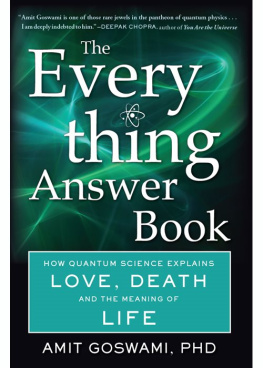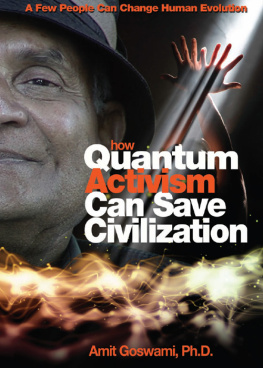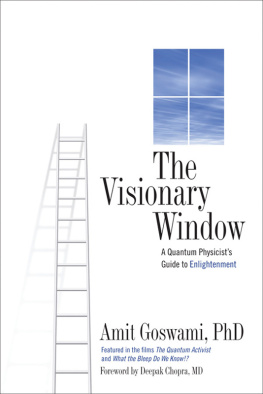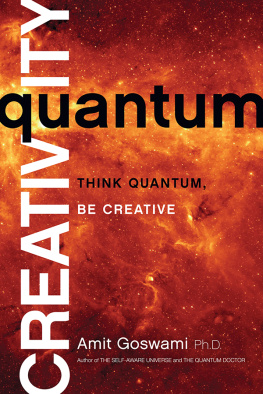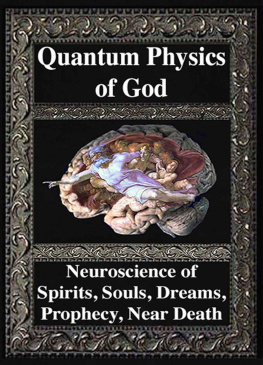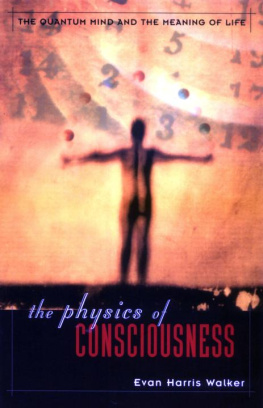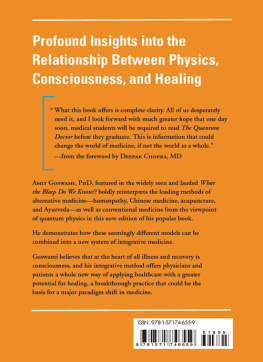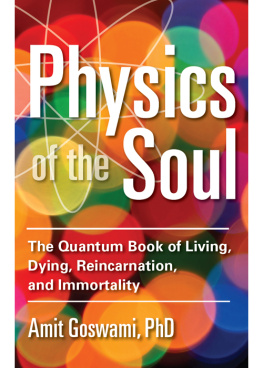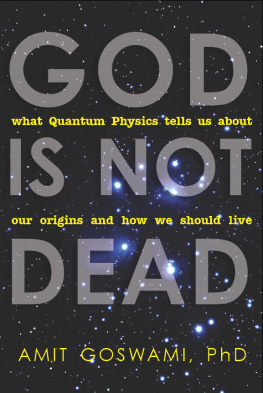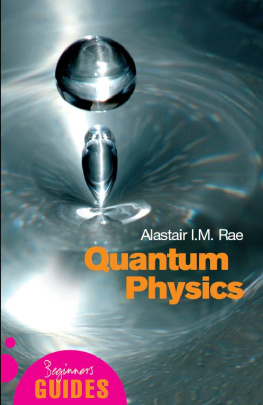

I dedicate this book to the quantum activistspast, present, and futureof the world.
We shall overcome.
Copyright 2017
by Amit Goswami
All rights reserved. No part of this publication may be reproduced or transmitted in any form or by any means, electronic or mechanical, including photocopying, recording, or by any information storage and retrieval system, without permission in writing from Red Wheel/Weiser, LLC. Reviewers may quote brief passages.
Cover design by Jim Warner
Cover photograph R. T. Wohlstradter/shutterstock
Interior by Timm Bryson, em em design
Typeset in Garamond Pro
Hampton Roads Publishing Company, Inc.
Charlottesville, VA 22906
Distributed by Red Wheel/Weiser, LLC
www.redwheelweiser.com
Sign up for our newsletter and special offers by going to www.redwheelweiser.com/newsletter/.
ISBN: 978-1-57174-762-4
Library of Congress Cataloging-in-Publication Data available upon request
Printed in Canada
MAR
10 9 8 7 6 5 4 3 2 1
www.redwheelweiser.com
www.redwheelweiser.com/newsletter
Contents
Acknowledgments
I thank Voice, Inc. for inviting me to Tokyo, and Masumi Hori for the dialogs I had with him. I thank Tatiana Hill for transcribing the tapes of those interviews. I thank Eva Herr for the interview that I had with her and many other journalists whose names I can't recall for their contributions as well. I thank Judith Greentree for a thorough reading of the manuscript and for some humorous comments that I incorporated into the book. Heartfelt thanks are due to Sara Sgarlat, Mimi Hill, and Terry Way for their contributions. I thank the editorial staff of Hampton Roads for a wonderful job of production. I thank you all.
Introduction
Almost one hundred years have passed since the complete mathematical formulation of quantum physics. It has been verified by myriad experiments and its concepts have been successfully applied in many technologies. Indeed, we have begun to use the word quantum in our daily discourseoften without fully understanding its deeper meaning. And yet, despite its effective integration into our society, the quantum worldview has still not been fully accepted by the scientific community, which continues to espouse and defend the archaic Newtonian worldview. Consequently, the full implications of the quantum worldview have not yet penetrated the public mind. The good news is that, in the 1990s, thanks to the efforts of an avant-garde group of renegade scientists including myself, the quantum worldview began to mature and gave birth to an all-inclusive new scientific paradigm. A grass roots movement known as quantum activism has begun to dislodge the stranglehold of Newtonian physics on the scientific establishment by appealing directly to people. This book is a part of that movement and the latest popular exposition of the quantum worldview.
Part of the mischief derives from circumstances. The prevailing Newtonian paradigm was always fraught with paradoxes. Officially known as scientific materialism, this worldview proposed that everything exists merely as a phenomenon of mattermaterial movement in space and time, caused by material interaction. The paradoxes implicit in this view were never resolved. It wasn't until the 1980s and 1990s that scientific materialism came under serious scrutiny by the scientific community, prompted by new experimenal data. Previously, the worldview of scientific materialism was much aided by the shift of physics away from a philosophy-oriented European approach to the more pragmatic American approach that followed World War II. Before the 1950s, scientific materialism was firmly entrenched only in the dicisplines of physics and chemistrythe science of inanimate objects. After the 1950s, it also began to dominate biology (which became chemistry), the health sciences (which became almost mechanical), and eventually psychology (which became cognitive neuroscience).
The second party to the mischief was the inadvertent enthusiasm of well-meaning scientists to close off the debate surrounding the meaning of quantum physics as quickly as possible. So, a compromisedubbed famously (or should I say, infamously) the Copenhagen Interpretationwas reached. This interpretation was pioneered by the famous and amicable Niels Bohr, whom every physicist (including myself) worshipped.
The centerpiece of the Copenhagen Interpretation is called the complementarity principle, which, in its popularized form, is simply wrong, both theoretically and experimentally. Quantum mathematics says unequivocally that quantum objects are waves. But of course, experiments say that they are also particles. How can the same object be both a wavesomething that spreads outand a particlesomething that travels in a defined trajectory? The popular form of the complementarity principle resolves this wave-particle paradox by claiming that quantum objects are both waves and particles. The wave aspect is revealed in wave-measuring experiments; the particle aspect is revealed in particle-measuring experiments. But both aspects never show up in the same experiment and are thus called complementary.
However, the correct answer to the paradox of wave-particle dualityboth theoretically and experimentallyis this: Quantum objects are waves of possibility residing in a domain of reality outside of space and time called the domain of potentiality. Whenever we measure these objects, they reveal themselves as particles in space and time. So both the wave and the particle aspects of an object can, in fact, be detected in a single experiment. Unfortunately, the popularized version of the complementarity principle, which created the impression that the wave and particle aspects of an object both exist in space and time, misled an entire generation or two of physicists and caused them to close their minds to the really radical elements of quantum physics. In fact, quantum physics insists on a two-level reality, not the single space-time reality of Newtonian physics and scientific materialism. Moreover, quantum physics cannot possibly be made paradox-free without explicitly invoking consciousness.
But of course, it was the role of consciousness that kept the paradox alivenot in the mainstream, but in a cultish sort of way. In the 1980s, an experiment by Alain Aspect and his collaborators resolved the issue of a dual versus a single domain of reality by discerning the domain of potentiality from the domain of space and time. In the former, no signal is needed for communication; everything is instantaneuously interconnected. By contrast, in space and time, signals, always moving with a speed no greater than the speed of light, mediate communication, which always occurs in finite time.
What does it mean to say that the domain of potentiality is all instantaneously interconnected? Simply this: Everything in the domain of potentiality is one entity. In a scientific paper published in 1989, and again in 1993 in The Self-Aware Universe, I arrived at the paradox-resolving proposition that the domain of potentiality is our consciousnessnot in the form of ordinary ego-consciousness, but as a higher consciousness in which we are all one. In manifest awareness, we become separate partly due to the necessity of distinction from other objects (the subject-object distinction) and partly due to our individual conditioning. I also proposed that this higher One consciousness is causally empowered by
Next page
